New 2012 Introductions
New introductions primarily from our own wild seed collections that will become available during the course of the new season. Here divided into 3 sections:
Acer was not always at the top of our menu when out collecting seed,
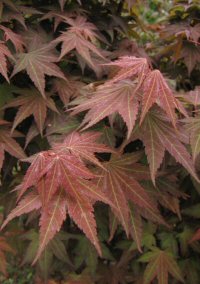 |
Acer duplicatoserratum BSWJ6886
or A. palmatum v. pubescens as it was known as at that time is in part responsible. The resulting seedlings of this Taiwanese endemic hit the spot for me. Relegated to our windswept stock field they have never failed to catch my eye no matter what the season. Unfortunately return as we might to the same location to collect more seed ends in disappointment, hence scarce it will remain.
|
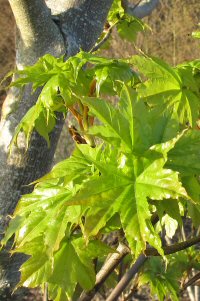 |
A. okamotoanum or what is correctly now known as Acer pictum ssp. okamotoanum BSWJ12623
was a happier encounter. The seed was fat and green with plenty for the taking, another endemic, this time of the South Korean remote island of Ullüngdõ. Germinating early until I happened to read that the seed is difficult to germinate, it stopped ……… weird or what?
|
Relief mixed with achievement were our emotions on re-finding
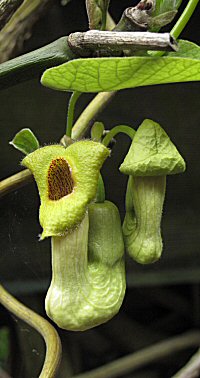 |
Aristolochia manshuriensis BSWJ12557 one of our key target plants for our 2010 expedition to South Korea. Again one of our most prized plants, given pride of place in our sales area where the large heart-shaped leaves unfurl after the large (for a hardy species) flowers have made their glowing display. Personally I would grow it for its foliage alone, the autumn yellow is astounding.
|
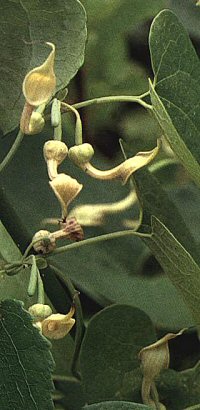 |
A. contorta BSWJ12613 has a different climbing habit, prior to this find we had only encountered it creeping along the ground close to the seashore. Hence finding this collection growing well in the centre of the country (where the winter temperatures would be very low) climbing over large shrubs and presenting us with some fat rounded seed capsules, left me scratching my head for an identification.
|
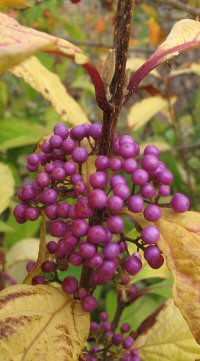 |
Callicarpa japonica BSWJ12621
was a collection from the same day, only forming small to medium sized shrubs in the area, differing in its variety that we already grow with larger foliage.
|
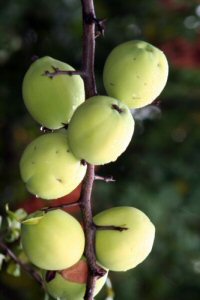 |
Chaenomeles cathayensis
is raised from seed from Ness Botanic Gardens, the original plants being from a seed collection gathered in China. They had formed multi-stemmed sprawling large shrubs there, in a small colony. The ground was strewn with the large yellow fruit, which I found irresistible and scooped up a whole bag of them to place in a bowl in the house. The fragrance was intoxicating for weeks until a friend offered to transform them into a jelly.
|
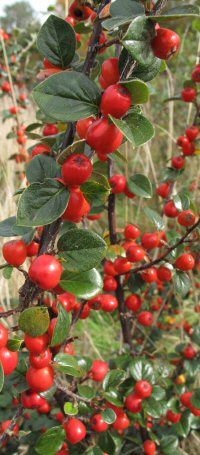
|
Cotoneaster ganghobaensis B&L12234 was another outstanding collection from Ness, the small shrubs of glossy foliage were so outstanding in fruit, that it took little convincing for me to collect some of it, has to be one of the best.
|
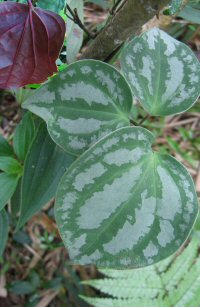 |
|
Clematis aff. smilacifolia BSWJ11767
Northern Vietnam is a host to many unfamiliar species of Clematis it was not until our fourth visit there that we were able to collect the large seed heads of C. aff. smilacifolia BSWJ11767 all be it still in a green state. As well as more collections, of this evergreen species with pronounced cup-shaped nodes, as cuttings from juvenile plants, which were purple on the undersides of the leaves, as well as silver patterned on the reverse side.
|
|
|
|
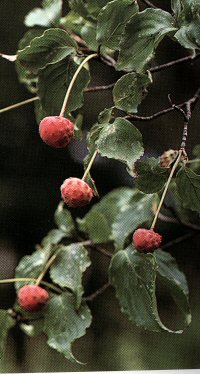 |
|
Cornus kousa BSWJ12610 is another fresh replacement collection from South Korea, this time hardly requiring an introduction. Shame I lost my photos (faulty memory card) I could have proved how bright and heavy the crop of plump fruit were.
|
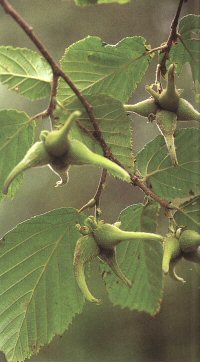 |
Corylus sieboldiana BSWJ11056
I have a soft spot for Corylus maybe it’s the squirrel in me, even as a child my parents would not see me for days as I used to roam the hills surrounding our farm collecting hazel nuts. C. sieboldiana BSWJ11056 was from a bit further away from home, I had seen it once before when in Korea in 1993, so it was like meeting up with an old friend when we came across a loaded specimen in Hiroshima Japan in 2005. The fruit are easily identified totally encased in the calyx which converge into a tail.
|
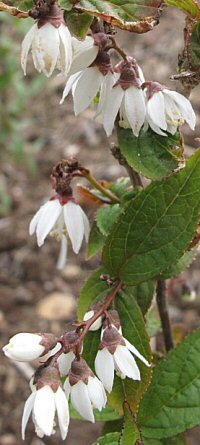 |
|
Deutzia taiwanensis BSWJ12443
Rolling back time to 1996 we were in the mountains of southern Taiwan where we collected seed of Deutzia taiwanensis for the first time. We are still waiting for it to flower! >> ff to 2007 to the forests of northern Taiwan and here we found Deutzia taiwanensis BSWJ12443 a daintier form. They germinated well so we commandeered a patch of our windswept stock field for some spare seedlings, blow me they flowered the very next summer as they have every year since. Even shrugging off the past three winters of at least –10C.
|
|
|
|
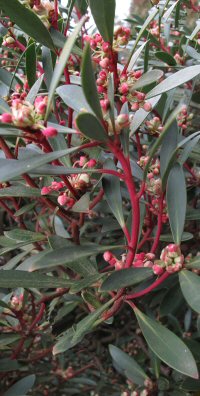
|
|
Drimys lanceolata is a stalwart in our gardens, with both male and female plants dotted around, hence we have plenty of its black fruit around clasping the deep red stems. As we are asked for it so often we have managed to raise some seedlings to offer those who do not seem to be able to find it elsewhere.
|
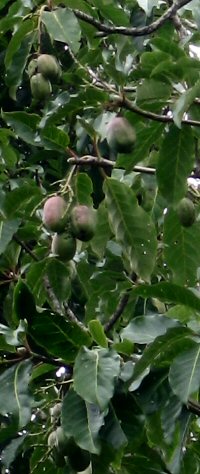 |
Elaeocarpus aff. griseopuberulus BSWJ11803
Elaeocarpus is a fairly well known tree or shrub in warmer parts of the world, bearing lovely fringed flowers against a foil of dramatic foliage. Our collection of E. aff. griseopuberulus BSWJ11803 originates from the more temperate mountain forests of northern Vietnam where we gathered the walnut-like fruit.
|
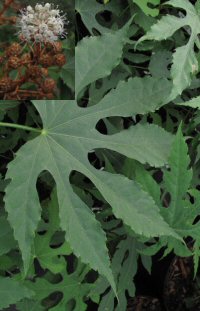 |
|
Fatsia polycarpa deeply cut leaf BWJ12499
Originating from the same mountain forests as our Tetrapanax papyrifer 'Di-Sue-Shan' as well as of course the same family is our latest collection Fatsia polycarpa deeply cut leaf BWJ12499. Easily distinguished from our previous collections with deeper, narrower and more numerous leaf-lobbing, still maintaining the more colourful gold-bronze inflorescences contrasting with the pincushion-like umbels of creamy flowers in the depth of winter.
|
|
|
|
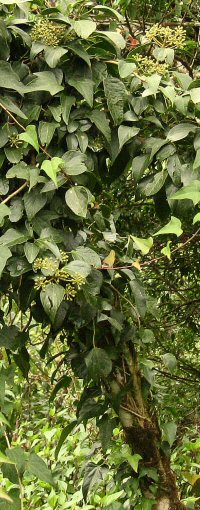 |
|
Coincidentally staying with this family Hedera sinensis v. sinensis KWJ12345 is a puzzling collection seeming to have more in common with the larger leafed species from closer to home. We have found it in several locations around the Hoang Lien mountain range in the very north of Vietnam, where we find so many hardy plants in this surprisingly temperate area.
|
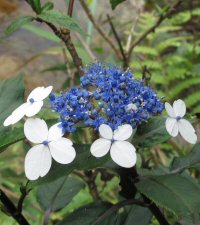 |
|
Hydrangea davidii This area is also rich in hydrangeas, a new name to this year’s offering is Hydrangea davidii which could be considered as just a name change. As these collections were previously offered as H. indochinensis. Whereas what we were offering as H. kwangsiensis is now considered to be H. indochinensis a species with glabrous thick textured semi-evergreen leaves. Confused
|
|
|
|
you have every right to be, I certainly am. A postscript in mitigation, the picture regarding hydrangeas in this part of the world is confused due to (in theory) hybridisation with Dichroa.
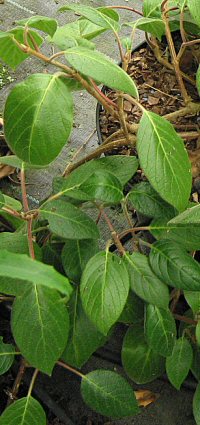 |
|
Schizophragma molle WWJ 11905 is another name change from the same family, even collected from the same area, introduced into cultivation by ourselves as S. aff. elliptifolium. You may be please to hear that we found more of it last autumn as well as another species still to be determined.
|
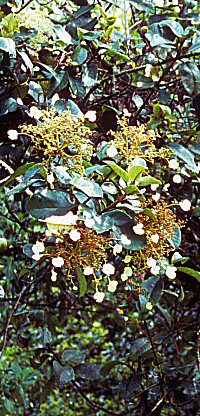 |
|
Hydrangea asterolasia BSWJ 10481 is from the other side of the world our gathering from the high plateau of Cordillera de Talamanca in Costa Rica. A climbing evergreen species with wide cymes of creamy white flowers backed by glossy textured leaves with conspicuous venation.
|
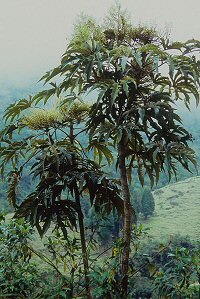 |
Oreopanax floribundus BSWJ10669
While we are in the Americas let me move south to the stunning central mountain range of Colombia where we found Oreopanax floribundus BSWJ10669 growing at high altitude on the edge of a dense forest. It took a considerable amount of research to identify (many thanks to Julian Shaw, for this and many more) as the only species I was familiar with had compound leaves made up of leaflets in a similar fashion to Schefflera. This species has distinct palmate leaves, covered in bristly hair thickly so on the contrasting pale undersides, while
|
the individual plants are dioecious (plants either male or female) bearing large terminal paniculate inflorescences.
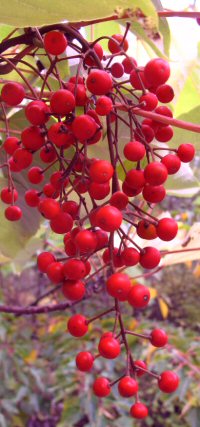
|
Idesia polycarpa CWJ12837
Moving smartly back to the mountains of Japan, this time where Finlay Colley and myself spent some time high up in the frozen alpine forests of Ehime. The large bright red pendulous long infructescences of Idesia polycarpa CWJ12837 were irresistible. We had seen them prior to this in southern Taiwan in 2007, but from this frozen cloud drenched location they must have less demand for heat. Hence should perform far better in our climate.
|
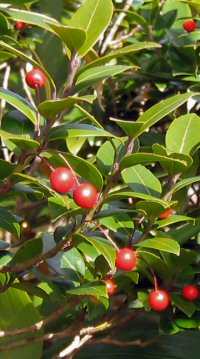 |
|
Ilex sugerokii v. brevipedunculata BSWJ10856
From much further north in the mountains of Aomori Ilex sugerokii v. brevipedunculata BSWJ10856 grew in almost arctic conditions, as a compact bun-like shrub with small ovate-serrated thick textured leaves bearing large(ish) red fruit on long stalks.
|
|
|
|
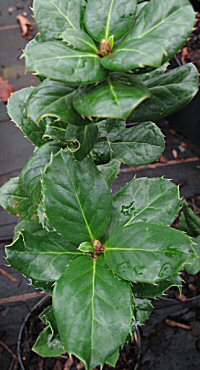
|
|
Ilex perado ssp. azorica BSWJ 12526 While from a less challenging Azorian mountainside I. perado ssp. azorica BSWJ12526 is also kept compact by its high latitudinal provenance. Growing with the odd Hedychium gardnerianum that can survive the more challenging conditions as well as the Viburnum discussed below. Back to the mountains of northern Vietnam where Illicium aff. lanceolatum KWJ12245 and I. aff. majus KWJ12017 are yet two more of our collections of this desirable genus originating from one of the worlds hotspots of diversity. We as well as The Arnold Arboretum believe that we have already collected eight species in this small area, with still more turning up.
|
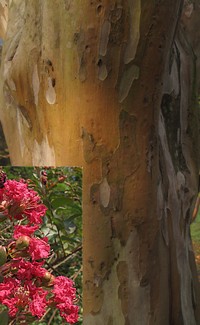
|
From South Korea we collected seed of Lagerstroemia indica BSWJ12660 a common site even in inland cold areas, but best sited in strong sun in our more northerly latitude. These will only be small plants initially, offered at this size as we have such a high demand for this genus, running out of room to grow them on as they enlarge.
|
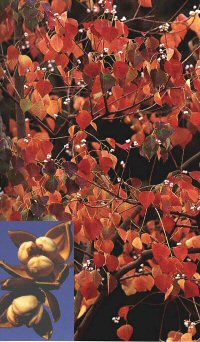 |
Neoshirakia sebiferum CWJ12819 is another candidate for a hot sunny site (formerly Sapium) differing to N. japonica in its more conspicuous inflorescences especially in fruit which splay open to reveal the waxy seed (hence the name tallow tree). Mahonia gracilipes is also added this year as it is so worthy of being grown in any garden. The sunlight on the leaf undersides in winter is a must for anyone who has a garden with a slope. Nandina domestica BSWJ11113 had been placed unceremoniously into one of our growing beds in our exposed stock field, where they have matured to wonderful colourful multi-stemmed compact shrubs. Must be our Welsh gales.
|
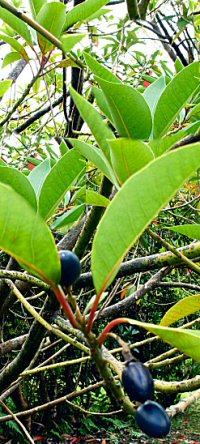 |
Persea indica BSWJ12535 would appear only to be found on the Azores, not able to resist attempting another species of these wonderful evergreens that were formerly Machilus a member of the laurel family.
|
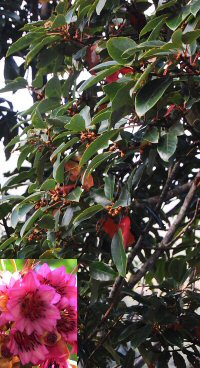 |
Another top ranking evergreen is Rhodoleia parvipetala WWJ11943, but this time from the Hamamelis family, which is difficult to equate to the more Rhododendron-like pink flowers on this species. In danger of repeating myself, I would grow this for its foliage alone, the contrasting white (and I mean white) leaf undersides stir inequitable passions in any plant freak. Hope you’re not on overload of my ramblings just yet, as there are a few more to go.
|
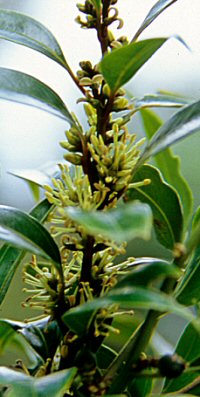 |
Sarcococca zeylanica BSWJ10199 is our latest addition our long inventory of Christmas box. The epithet may not be obvious to non-Latin scholars, but translates to Ceylon which of course is now Sri Lanka. We thought we had done well to find S. brevifolia there in 2002, (on a blinkered search for Disporum) as I had not done my homework before visiting there. Again in our defense, it was our fifth area of collection that season. Imagine my dismay on discovering the mention of a second species only when at home. It was a good excuse to spend Christmas of 2003 there though. Finding our quest easily just a hundred yards from where we turned around the previous year. There has to be a lesson or two to be learnt there.
|
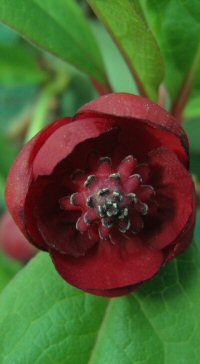 |
There has also to be a prize for not confusing the following two. Schisandra sphaerandra BWJ7739 is within the same group as S. grandiflora and S. rubiflora, i.e. with large (within the genus) scented flowers. Oxblood in this case, followed on the female plants by the long strings of bright red fruit.
|
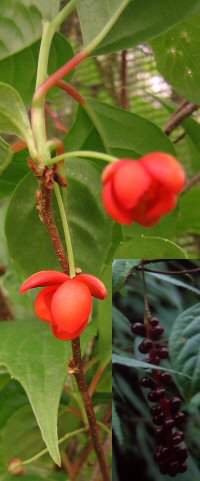 |
The fruit of Schisandra sphenanthera BWJ8151 are a distinct deep red-purple, while the flowers are orange-yellow, revealing this specie’s true identity, as we have been offering it as S. aff. bicolor previously.
|
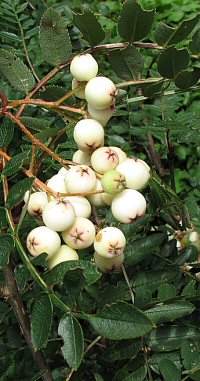 |
|
From section Multijugae of the genus Sorbus, Sorbus bissetii Yu14299 was rescued from obscurity or even extinction at Ness BG. A small leafed species with eventual white fruit, this species is in good company, still worthy of its space as it is sufficiently distinct.
|
|
|
|
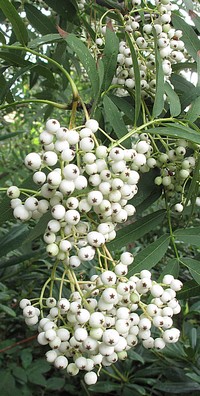
|
|
From the section Discolores is another outstanding white fruiting species that has come to us via Ness BG. Sorbus discolor MF97103 is a sturdier larger leafed species with foliage not too dissimilar to our native mountain ash while the abundant fruit is pure white, held in weighted pendant panicles.
|
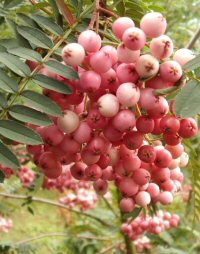 |
|
Sorbus aff. vilmorinii KR6453 is a more complex species (even worthy of a cultivar name) which our boffins at Ness BG are having difficulty pinning down to a species. Nonetheless it is a top rated plant with relatively large white fruit lacking the crimson-red on the immature fruit. Forming a ‘highly attractive, heavily fruiting tree’ at Ness BG.
|
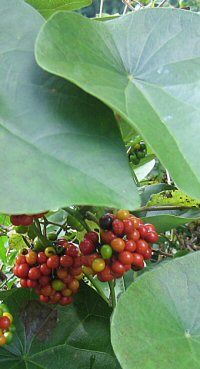 |
Stephania japonica one of the moon seeds, represented by my seed collection Stephania japonica CWJ12823, is virtually unknown in cultivation. It is an herbaceous twinning climber with delicate looking peltate leaves. The young foliage has translucent properties, which I just find irresistible. Imagine my delight on finding a grove of mature plants in southern Japan with Finlay Colley during our foray in the autumn of 2010. Didn’t take long to gather that red fruit into my bag.
|
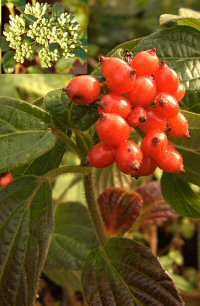 |
|
Red fruit is also an important feature of Viburnum hoanglienense BSWJ8281, essentially a name change which we are delighted to have played a major part in. In so much as it is one of our discoveries, named for the Hoang Lien mountain range where we have collected the distinct plump long persistent fruit several times. This against the foil of distinctly softly hairy dark green textured foliage.
|
|
|
|
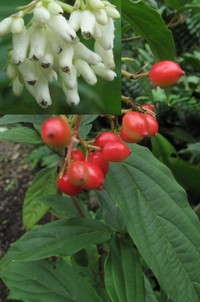
|
|
Viburnum fansipanense BSWJ8302, as with the preceding species, is another of our discoveries also from the same mountain range, but this time named for the highest peak Fansipan. The foliage is long-elliptic with conspicuous venation, evergreen for us, but may well be deciduous in colder areas. All the same we are treated to some good autumn colour. The species is distinct in its long pure white cylindrical flowers with contrasting black protruding stamen, held in rounded cymes. Followed by oblong red fruit produced in abundance continuing the ornamental quality of this species into the winter.
|
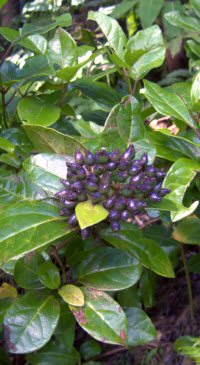 |
|
The pointed fruit of Viburnum tinus v. subcordatum BSWJ12544 are purple held in large tight rounded cymes as naturally would be the white flowers which are produced in the winter months. From the limited experience we have had with this distinct variety of this most popular of evergreen shrubs it appears hardier than one would expect from its origins in the Azores, but that may well be because of the altitude we gathered the fruit from.
|
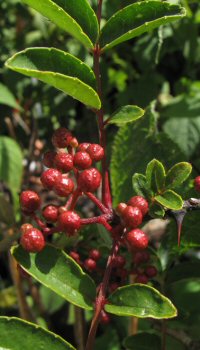 |
I have distinct memories of collecting the fruit of Zanthoxylum bungeanum Sichuan Pepper BWJ8040 from a hot dusty roadside in Sichuan, when it was pointed out to me as being the cause of many of our fiery meals over the past weeks. Having virtually overdosed on it my enthusiasm was not quite at its peak, hence I only gathered a few seed. Not taking into consideration that if you add red hot chillies at equal proportions as the accompanying food ones food does get on the fiery side. The upshot of it all is that I ended up with a solitary plant from which it has taken me many years to produce seed to propagate from. But at least I know the plants are self compatible.
|